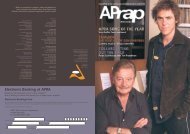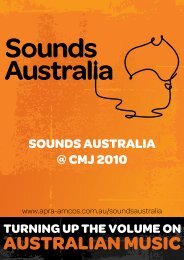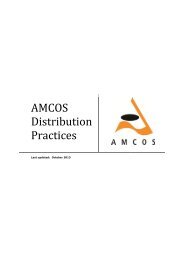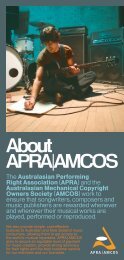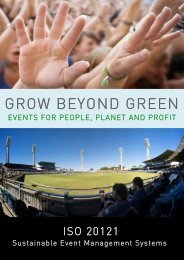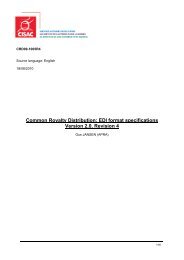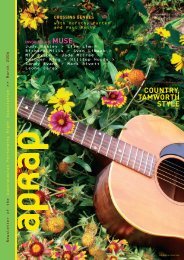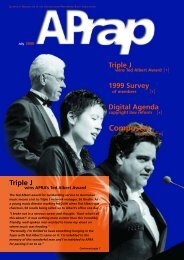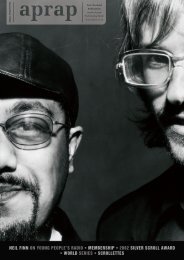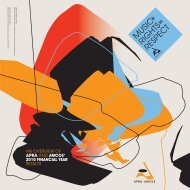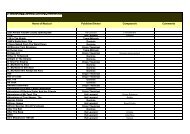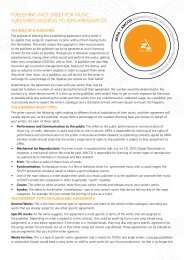CLARE BOWDITCH - APRA
CLARE BOWDITCH - APRA
CLARE BOWDITCH - APRA
Create successful ePaper yourself
Turn your PDF publications into a flip-book with our unique Google optimized e-Paper software.
Richard Tognetti. Photo by Paul Henderson-Kelly<br />
courtesy of ABC Classics<br />
>> Cape of Storms<br />
>> Cape of Storms<br />
>> Michael, Richard, Afro, Tom & Jim >> Amanda Brown<br />
S C R E E N C O M P O S E R S A N D T H E I R A R T<br />
Compiled by Kirti Jacobs and Anthea Sarris, <strong>APRA</strong> Communications<br />
According to the Australian Film Commission* twenty-five Australian<br />
features started production in 2005/06. This is the most since the turn<br />
of the decade and more than the five-year average. The budgets of these<br />
films increased from $66 million to $98 million. More films mean more<br />
work for Australia’s screen composers and hopefully are a sign of a<br />
more prosperous period for Australia’s film and film music creators.<br />
We spoke to five writers who have<br />
arrived at composing for the screen<br />
in quite different ways. Their screen<br />
credits reflect not only their breadth and<br />
depth of talent, but also the diversity of<br />
musical styles employed on Australian<br />
film and TV productions. Aprap turns the<br />
spotlight on the art, the craft and the<br />
challenges of composing for the screen.<br />
*National survey of feature film and TV drama<br />
production 2005/06.<br />
Cape of Storms smooth<br />
sailing for composers<br />
“Art for art’s sake is a rare and<br />
wonderful thing. This film was art<br />
for art’s sake.”<br />
Richard Tognetti, Artistic Director and<br />
Lead Violin for the Australian Chamber<br />
Orchestra, is talking about Horrorscopes:<br />
Cape of Storms, a Quiksilver documentary<br />
about surfing the world’s biggest waves<br />
off South Africa’s Cape of Good Hope.<br />
Directed by Justin McMillan and Chris<br />
Nelius, it features a team of crazy bigwave<br />
surfers including Australians Tom<br />
Carroll (who got Tognetti into the film)<br />
and Ross Clarke-Jones, taking on the<br />
fearsome, shark and kelp infested waters<br />
off the Cape. The soundtrack is an original<br />
score by Tognetti, co-composer with Iva<br />
Davies and Chris Gordon for Peter Weir’s<br />
Master and Commander, and Michael<br />
Yezerski, composer Newcastle, Kenny,<br />
No Surrender, Thursday’s Fictions.<br />
A score for<br />
a time and place<br />
Featuring vocals by Afro Moses (credited<br />
as a co-composer), the Cape of Storms<br />
score captures the mythic and legendary<br />
character of the setting and the surfing<br />
adventure.<br />
The sense of journey and place were<br />
important inspirations for both Yezerski<br />
and Tognetti.<br />
“With Cape of Storms, we wanted this<br />
feeling of awe and incredible journey; of<br />
being very alone and human and pitted<br />
against the almighty force of the ocean.”<br />
says Tognetti.<br />
It helped that surfing imagery lends<br />
itself very well to music. As Yezerski<br />
says, “It is a graceful and beautiful<br />
activity, with movements not dissimilar<br />
to dance. We were able to take our<br />
cues from the rhythms and tempi of the<br />
surfers and the waves.”<br />
Screen composing:<br />
a collaborative labour<br />
of love<br />
Tognetti counts himself lucky to have<br />
been involved in two films thus far: “The<br />
best way to make art is without ambition.<br />
Ambition often gets in the way. Screen<br />
composing is applied music. You have to<br />
be incredibly fleet of foot. You have to<br />
be able to change course and direction,<br />
really quickly.”<br />
Yezerski adds, “Screen composers must<br />
be able to engage socially – and enjoy<br />
it! In my experience, producers and<br />
directors don’t tend to want to work with<br />
‘artistes’ who simply dispense music from<br />
their ivory towers. Screen composers are<br />
always part of a team and cannot create<br />
their music in a vacuum.”<br />
That said, it’s important to hold on to<br />
your ideas. Tognetti: “David Lynch once<br />
said if you give up on an idea because<br />
some executive says it’s not going to<br />
work, you lose the kernel that created<br />
the seed, the gestation that created<br />
the whole life force. Watching Peter<br />
Weir work with his inspiration within<br />
this maelstrom of business distraction<br />
[for Master & Commander] – that<br />
emboldened me. The idea is the most<br />
important thing. Never ever give up<br />
on it, even though you might have to<br />
change the way it comes across.”<br />
Amanda Brown:<br />
the Go Between who<br />
Looked Both Ways<br />
Renowned as the violinist with<br />
The Go Betweens during their<br />
classic era, Amanda Brown is also<br />
a sought after session musician<br />
and screen composer. Her screen<br />
credits include Look Both Ways,<br />
Preservation, Floodhouse.<br />
How does your Go Betweens experience<br />
inform your work with film?<br />
Playing in bands taught me to improvise,<br />
and composing is like controlled<br />
improvising. I have also built up a<br />
wonderful stable of musicians and friends<br />
that I call on for various projects.<br />
How does one build a sustainable career<br />
out of screen composition?<br />
You don’t work in the arts in Australia<br />
for monetary gain! What works for me<br />
has been versatility. There are bound<br />
to be lean times so it helps to be multi<br />
skilled. I do a number of part time<br />
jobs, including session work for other<br />
bands, studio engineering and teaching.<br />
Because they’re all music related, I’m<br />
always learning and being inspired by<br />
these ancillary jobs.<br />
What are some of the challenges of<br />
composing for film?<br />
Film music in one part of a collective<br />
whole art form and has to support the<br />
storytelling of the film. There will be<br />
times when the music will be drowned<br />
out by sound effects or relegated to the<br />
cutting room floor so you have to check<br />
your ego at the door. Technically the<br />
look and narrative of the film suggest<br />
certain parameters in regards to tempo,<br />
arrangement and style.<br />
How do you “read” a film before you<br />
begin to compose?<br />
Usually the director has a definite idea<br />
of where the music cues should fall and<br />
sometimes of musical style as well. I<br />
try to find the right instrumentation<br />
first, depending on the period of the<br />
film and what suits the characters and<br />
storyline. Then I find the tempo for the<br />
scene, and think about whether leitmotif<br />
or underscore is appropriate and then<br />
I make my first painstaking tentative<br />
forays onto the blank canvas.<br />
How does music function as a part of<br />
the drama of story telling?<br />
Music can work in all kinds of ways,<br />
supporting the drama, reinforcing<br />
themes, even going completely against<br />
convention to create parody or the<br />
complete opposite of what is happening<br />
visually. The way music can change a<br />
scene constantly amazes me.<br />
How do you know when you’ve been<br />
successful?<br />
When the scene I’m working on is<br />
improved by the presence of music.<br />
There is this intangible moment when<br />
the visual and the aural combine to<br />
create something I can only describe as<br />
magical, almost like being suspended in<br />
time, spellbound.<br />
A P R A P D E C E M B E R 2 0 0 6 > > 1 0



